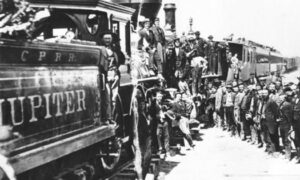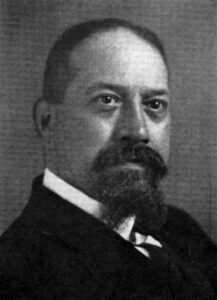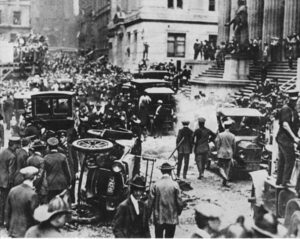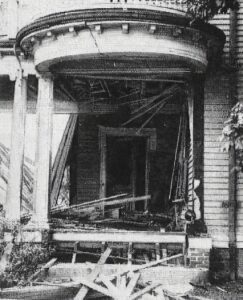Monthly Archives: June 2024

 My in-laws, Walt and Joann Schulenberg knew each other their whole lives. They were from the small town of Forsyth, Montana, and their mothers, Vina Schulenberg Hein and Nettie Knox were good friends. They did things together and hung out for pleasant afternoon visits while their children slept. Walt was the older of the two by a year and a half, but they were still playmates as kids, and they even took naps together, which was something that embarrassed my rather prim and proper mother-in-law. Oh, she wasn’t a snob, but in those days, people just didn’t do that sort of thing (the sleeping together, not the napping part). Mostly it was a matter of the fact that you just didn’t talk or joke about such things, Nevertheless, we all teased them…well mostly her, because it didn’t bother my father-in-law one bit.
My in-laws, Walt and Joann Schulenberg knew each other their whole lives. They were from the small town of Forsyth, Montana, and their mothers, Vina Schulenberg Hein and Nettie Knox were good friends. They did things together and hung out for pleasant afternoon visits while their children slept. Walt was the older of the two by a year and a half, but they were still playmates as kids, and they even took naps together, which was something that embarrassed my rather prim and proper mother-in-law. Oh, she wasn’t a snob, but in those days, people just didn’t do that sort of thing (the sleeping together, not the napping part). Mostly it was a matter of the fact that you just didn’t talk or joke about such things, Nevertheless, we all teased them…well mostly her, because it didn’t bother my father-in-law one bit.
The two of them grew apart s their school years went on, and my mother-in-law told me that she really didn’t like him much then. My guess is that he was always joking around and she didn’t think it was all that funny.  Nevertheless, he persevered and soon he won her heart. They talked about what their future would hold…things like how many kids they would have and the fact that he wanted a little girl, just like her baby sister, Margee Kountz. He loved kids, and he wanted a bunch of them. And a bunch of them, they did have. They had six kids all together…Marlyce Schulenberg (who passed away when she was 39 years old), Debbie Cook, Bob Schulenberg, Jennifer Parmely, Brenda Schulenberg, and Ron Schulenberg. Their lives would soon take them far from Forsyth, as he looked for better work opportunities. They finally landed in Casper, Wyoming, as would several of their family members. That is where they spent the rest of their lives, with the exception of a few years when they wintered in Yuma, Arizona…a place they grew to love and where they had many friends.
Nevertheless, he persevered and soon he won her heart. They talked about what their future would hold…things like how many kids they would have and the fact that he wanted a little girl, just like her baby sister, Margee Kountz. He loved kids, and he wanted a bunch of them. And a bunch of them, they did have. They had six kids all together…Marlyce Schulenberg (who passed away when she was 39 years old), Debbie Cook, Bob Schulenberg, Jennifer Parmely, Brenda Schulenberg, and Ron Schulenberg. Their lives would soon take them far from Forsyth, as he looked for better work opportunities. They finally landed in Casper, Wyoming, as would several of their family members. That is where they spent the rest of their lives, with the exception of a few years when they wintered in Yuma, Arizona…a place they grew to love and where they had many friends.
As time went on, they were blessed with grandchildren, Corrie Petersen, Amy Royse, Machelle Moore, Barry Schulenberg, Nancy Cook (who passed away shortly after her birth), Susan Griffith, JD Parmely, and Eric Parmely. They also had great grandchildren, Chris Petersen, Shai Royce, Caalab Royce, Josh Petersen, Weston Moore, Jala Satterwhite, Easton Moore, Kaytlyn Griffith, Reagan Parmely, Hattie Parmely, Bowen Parmely, and 
 Maeve Parmely. In addition, they now have great great grandchildren, Cambree Petersen, Caysen Petersen, Justin Petersen, Axel Petersen, and Cyler Petersen. A number of these, they never had the privilege of meeting, sadly. Nevertheless, little did they know, when they started out, just how far-reaching their love would be. Their family has grown so much, and it’s not done growing yet. Today marks the 75th anniversary of my in-laws, Walt and Joann Schulenberg’s wedding. I wish they could be here to celebrate. Happy anniversary in Heaven, Mom and Dad. We love and miss you very much.
Maeve Parmely. In addition, they now have great great grandchildren, Cambree Petersen, Caysen Petersen, Justin Petersen, Axel Petersen, and Cyler Petersen. A number of these, they never had the privilege of meeting, sadly. Nevertheless, little did they know, when they started out, just how far-reaching their love would be. Their family has grown so much, and it’s not done growing yet. Today marks the 75th anniversary of my in-laws, Walt and Joann Schulenberg’s wedding. I wish they could be here to celebrate. Happy anniversary in Heaven, Mom and Dad. We love and miss you very much.

 Sometimes, what seems like a necessary change, and what might have been done with good intentions, ends up being far more detrimental than helpful. In the United States, from 1879 to 1933 our monetary system was based on and utilized gold. The lone exception to that was the embargo on gold exports during World War I. With the gold standard, creditors had the right to demand payment in gold. It was a stable and tangible source of income and payment, and it ensured that the borrower actually had the funds to make the payment. The bank failures during the Great Depression of the 1930s frightened the public, causing them to begin hoarding gold, making the “payment in gold” policy untenable, furthering the panic. On June 5, 1933, Congress enacted a joint resolution nullifying the right of creditors to demand payment in gold, thereby taking the United States off the gold standard. That meant that our currency was no longer backed by gold. This may not have seemed like a bad solution at the time, but it certainly opened the door for a number of huge problems later.
Sometimes, what seems like a necessary change, and what might have been done with good intentions, ends up being far more detrimental than helpful. In the United States, from 1879 to 1933 our monetary system was based on and utilized gold. The lone exception to that was the embargo on gold exports during World War I. With the gold standard, creditors had the right to demand payment in gold. It was a stable and tangible source of income and payment, and it ensured that the borrower actually had the funds to make the payment. The bank failures during the Great Depression of the 1930s frightened the public, causing them to begin hoarding gold, making the “payment in gold” policy untenable, furthering the panic. On June 5, 1933, Congress enacted a joint resolution nullifying the right of creditors to demand payment in gold, thereby taking the United States off the gold standard. That meant that our currency was no longer backed by gold. This may not have seemed like a bad solution at the time, but it certainly opened the door for a number of huge problems later.
President Roosevelt had seen how this worked when Britain was facing similar pressures, and they decided to drop the gold standard in 1931. So, when the Great Depression hit, Roosevelt decided to implement it in the US. Soon after taking office in March 1933, President Roosevelt declared a nationwide bank moratorium in order to prevent a run on the banks by consumers lacking confidence in the economy. At the same time, he forbade banks from paying out gold or to exporting it. He based his decision on the Keynesian economic theory, which states that one of the best ways to fight off an economic downturn is to inflate the money supply. If the amount of gold held by the Federal Reserve is increased, it would in turn increase its power to inflate the money supply.
With that in mind, Roosevelt, on April 5, 1933, ordered all gold coins and gold certificates in denominations of more than $100 turned in for other money. The order required all persons to deliver all gold coin, gold bullion, and gold certificates owned by them to the Federal Reserve by May 1, 1933. In exchange, they were to be given $20.67 per ounce. I’m sure it seemed like a good deal, so the people complied. By May 10, the government had taken in $300 million of gold coin and $470 million of gold certificates. Congress two months later, enacted a joint resolution repealing the gold clauses in many public and private obligations that required the debtor to repay the creditor in gold dollars of the same weight and fineness as those borrowed. To complete the inflation process, in 1934, the government price of gold was increased to $35 per ounce, effectively increasing the gold on the Federal Reserve’s balance sheets by 69 percent. This increase in assets allowed the Federal Reserve to further inflate the money supply. So, with a stroke of the pen, the Federal Reserve, and thereby the government increased their wealth by 69%…overnight.
The $35 per ounce value of gold held August 15, 1971, when President Richard Nixon announced that the United States would no longer convert dollars to gold at a fixed value, thus completely abandoning the gold standard. Now I’m not an economist, but if I understand this correctly, it was at that point that the United States, as well as many other nations, began using what is known as “Fiat Money.” Fiat money is “a type of currency that is not backed by a precious metal, such as gold or silver. Fiat money is an intrinsically valueless object or record that is accepted widely as a means of payment. Accordingly, the value of fiat money is greater than the value of its metal or paper content.” It is designated by the issuing government to be legal 
 tender and it was authorized by government regulations, which means that the government could decide what its value would be. That would render the money to be worthless. Not that it changed much in the amounts of Fiat money in use at the time, but in 1974, President Gerald Ford signed legislation that permitted Americans to own gold bullion again.
tender and it was authorized by government regulations, which means that the government could decide what its value would be. That would render the money to be worthless. Not that it changed much in the amounts of Fiat money in use at the time, but in 1974, President Gerald Ford signed legislation that permitted Americans to own gold bullion again.
 When people started moving west in the United States, the trips took approximately four months by wagon train. At that time, saying “goodbye” to loved ones was a very sad moment, because many times people would never see each other again. The distance was just too great and the cost too much, and unless people were moving permanently, they simply couldn’t take the trip. At that time…the 1860s, they likely had no idea that things would get easier either.
When people started moving west in the United States, the trips took approximately four months by wagon train. At that time, saying “goodbye” to loved ones was a very sad moment, because many times people would never see each other again. The distance was just too great and the cost too much, and unless people were moving permanently, they simply couldn’t take the trip. At that time…the 1860s, they likely had no idea that things would get easier either.
Nevertheless, just a short sixteen years later, all that changed. The train wasn’t a completely new invention in the 1860s, and in fact was invented in 1829. Still, as the United States was experiencing its expansion to the west, there were few towns and no railroads. So, moving west still meant that families might never see their departing loved ones again, and if the did, it would be a number of years. During the early 19th century, when Thomas Jefferson first dreamed of an American nation stretching from “sea to shining sea,” it took the president 10 days to travel the 225 miles from Monticello to Philadelphia via carriage. The distance from New York to San Francisco (which was founded in 1776, but didn’t become part of the United States until the signing of the Treaty of Guadalupe Hidalgo in 1848). Jefferson was president from 1801 to 1809. The distance from New York City to San Francisco is 2,565 miles from New York City, making the carriage time in those days approximately 114 days, or a little less than a third of a year. If you weren’t moving west, you would also have to make the return trip. It just wasn’t feasible.
Jefferson saw a possible answer to his dilemma as early as 1802, with “the introduction of so powerful an agent as steam.” At that time, he predicted, the possibility of “a carriage on wheels” that would make “a great change in the situation of man.” For Jefferson, the change would not come soon enough, and he never witnessed the  “carriage on wheels” he had envisioned. Nevertheless, within half a century, America would have more railroads than any other nation in the world, and by 1869, America would see the first transcontinental line linking the coasts was completed. Now, those journeys that were impossible for any reason but moving, that had previously taken months using horses, could be made in less than a week. In fact, on June 4, 1876, the Transcontinental Express train traveled from New York City to San Francisco in a mere 83 hours.
“carriage on wheels” he had envisioned. Nevertheless, within half a century, America would have more railroads than any other nation in the world, and by 1869, America would see the first transcontinental line linking the coasts was completed. Now, those journeys that were impossible for any reason but moving, that had previously taken months using horses, could be made in less than a week. In fact, on June 4, 1876, the Transcontinental Express train traveled from New York City to San Francisco in a mere 83 hours.
It seemed inconceivable that a human being could travel across the entire nation in less than four days. Nevertheless, now the impossible had become not only possible, but a reality, and the United States became a very mobile nation. Prior to that time, the coast were months apart, and it was speculated that the nation couldn’t possibly stay united. They couldn’t even communicate very well, much less see each other. Now, those problems were in the past. Just five days later, daily passenger service began. You simply can’t hold progress back. Once the technology is available, the reality isn’t far behind. Americans were amazed at the speed and comfort of this new form of travel. Of course, it wasn’t for everyone, because as with all new inventions, it was expensive and therefore, only for the wealthy. The train was luxurious, with first-class passengers riding in beautifully appointed cars with plush velvet seats that converted into snug sleeping berths. The finer amenities included steam heat, fresh linen daily and gracious porters who catered to their every whim. For an extra $4 a day, the wealthy traveler could opt to take the weekly Pacific Hotel Express, which offered first-class dining on board. As one happy passenger wrote, “The rarest and richest of all my journeying through life is this three-thousand miles by rail.”
A third-class ticket could be purchased for only $40–less than half the price of the first-class fare. At this low rate, the traveler received no luxuries. Their cars, fitted with rows of narrow wooden benches, were congested,  noisy and uncomfortable. The railroad often attached the coach cars to freight cars that were constantly shunted aside to make way for the express trains. Consequently, the third-class traveler’s journey west might take 10 or more days. Still, no one complained, because 10 days was far better than four months, and sitting on a hard bench seat was still much better than six months walking alongside a Conestoga wagon on the Oregon Trail. Of course, this amazing method of transportation would only be amazing for a short time in history, as trains gave way to cars and eventually airplanes. Still those things were either a way off, or would have to wait for the necessary roads and airports to make those forms of travel available. Trains were here now, and life was good!!
noisy and uncomfortable. The railroad often attached the coach cars to freight cars that were constantly shunted aside to make way for the express trains. Consequently, the third-class traveler’s journey west might take 10 or more days. Still, no one complained, because 10 days was far better than four months, and sitting on a hard bench seat was still much better than six months walking alongside a Conestoga wagon on the Oregon Trail. Of course, this amazing method of transportation would only be amazing for a short time in history, as trains gave way to cars and eventually airplanes. Still those things were either a way off, or would have to wait for the necessary roads and airports to make those forms of travel available. Trains were here now, and life was good!!
 In late April 1919, anarchists, a group of people who believe that “society should have no government, laws, police, or any other authority. Most anarchists in the US advocate change through non-violent, non-criminal means. However, a small minority believed change could only be accomplished through violence and criminal acts” decided to take matters into their own hands. If you ask me, their actions proved without a doubt, why we need thinks like government (but not BIG government), laws, police, and other authority figures. In these bombings, radicals mailed over 30 booby trap dynamite-filled bombs to prominent politicians and appointees, including the Attorney General of the United States, as well as justice officials, newspaper editors, and businessmen, such as John D Rockefeller, and the mayor of Seattle, Washington. All but one of the bombs were addressed to high-level officials, but strangely, one bomb was notably addressed to the home of a Federal Bureau of Investigation field agent, Rayme Weston Finch, who had been tasked with investigating the Galleanists, and who in 1918 had arrested two prominent Galleanists while leading a police raid on the offices of their publication Cronaca Sovversiva. No one was killed in these bombings, but unfortunately, one senator’s maid lost her hands.
In late April 1919, anarchists, a group of people who believe that “society should have no government, laws, police, or any other authority. Most anarchists in the US advocate change through non-violent, non-criminal means. However, a small minority believed change could only be accomplished through violence and criminal acts” decided to take matters into their own hands. If you ask me, their actions proved without a doubt, why we need thinks like government (but not BIG government), laws, police, and other authority figures. In these bombings, radicals mailed over 30 booby trap dynamite-filled bombs to prominent politicians and appointees, including the Attorney General of the United States, as well as justice officials, newspaper editors, and businessmen, such as John D Rockefeller, and the mayor of Seattle, Washington. All but one of the bombs were addressed to high-level officials, but strangely, one bomb was notably addressed to the home of a Federal Bureau of Investigation field agent, Rayme Weston Finch, who had been tasked with investigating the Galleanists, and who in 1918 had arrested two prominent Galleanists while leading a police raid on the offices of their publication Cronaca Sovversiva. No one was killed in these bombings, but unfortunately, one senator’s maid lost her hands.
With the epic failure of the first bombings fresh in their minds, the anarchists decided to try again. On June 2, 1919, in seven US cities, all within approximately 90 minutes of each other, bombs once again rock the area. These bombs were much bigger. Explosions took place in some of the most significant urban areas in America, including New York, Boston, Pittsburgh, Cleveland, Washington DC, Philadelphia, and Patterson, New Jersey. It is believed that the bombers were most likely disciples of Luigi Galleani, an extremely radical anarchist who pushed for violence to rid the world of laws and capitalism. The bombs exploded on June 2 were much larger than those sent in April. They comprised up to 25 pounds of dynamite packaged with heavy metal slugs, which were designed to act as shrapnel. The bombs were sent to government officials who had endorsed anti-sedition laws and deportation of immigrants suspected of crimes or associated with illegal movements, as well as judges who had sentenced anarchists to prison.
One of the bombs was set off by a militant anarchist named Carlo Valdinoci, who was a former editor of the Galleanist publication Cronaca Sovversiva and close associate of Luigi Galleani. Sovversiva planted the bomb, but as he as he set it, it blew up the front of newly appointed Attorney General A Mitchell Palmer’s home in Washington, DC. Unfortunately for Sovversiva, the bomb exploded too early, and he was killed in the very blast he created. At the time, a young Franklin and Eleanor Roosevelt lived across the street and were also shaken by the blast. That bombing was just one in a series of coordinated attacks that day on judges, politicians, law enforcement officials, and others in eight cities nationwide.
Within minutes of the bombing of US Attorney General Palmer’s home, more were exploding in other cities, including Philadelphia, Pennsylvania. Here, two bombs exploded within seconds of each other under the porch of the rectory of the Our Lady of Victory Catholic Church, caving in the porch and shattering every window in the rectory and those in the basement. The church was still smoldering when another bomb exploded less than a mile away at the home of Philadelphia jeweler Louis Jajieky. That also seems like an unlikely target, given the political nature of most of the bombs. The interior of the Jajieky residence was utterly demolished, leaving only the exterior four walls standing. 
While the anarchists were persistent, they were not especially “good” anarchists. During these bombings and simultaneous explosions in six other cities, none of the men who were being targeted were killed, but one bomb took the life of New York City night watchman William Boehner. Each of the bombs was delivered with several copies of a pink flyer titled “Plain Words,” which read, “War, Class war, and you were the first to wage it under the cover of the powerful institutions you call order, in the darkness of your laws. There will have to be bloodshed; we will not dodge; there will have to be murder: we will kill because it is necessary; there will have to be destruction; we will destroy to rid the world of your tyrannical institutions.”
It was discovered that the flyer was printed in a printing shop operated by two anarchists, Andrea Salsedo, who was a typesetter, and Roberto Elia, who was a compositor. Bothe of them were known Galleanists. Rather that go to jail, Salsedo committed suicide. Elia was given the opportunity to testify about his role, and thereby avoid deportation, but he refused the offer. Unfortunately, the prosecutors could not obtain enough evidence to proceed with a criminal trial. Authorities continued to deport known Galleanists using the Anarchist Exclusion Act and related statutes.
The predecessor to the FBI, the federal investigation in Philadelphia, headed by Special Agent Todd Daniel and the Bureau of Investigation’s Acting Director, William Flynn had been investigating these anarchists. Days after the bombings, Special Agent Daniel said, “The terrorist movement is national in scope, and its headquarters may be located in this city [Philadelphia].” Daniel also noted the large number of “anarchists in this city and so many places used by them for meeting places.” Daniel’s first thought was that the perpetrators of the Philadelphia bombings were members of the Industrial Workers of the Word (a leftist union that embraced socialistic principles). On June 5, federal and local investigators were tracking down members of the “bomb-throwing squad,” which was said to have included women. They had 12 radicals suspected of having a hand in the city’s attacks under constant surveillance.
At the time of the bombings, there was already a lot of anxiety in America. The world was in the middle of a deadly wave of the pandemic flu, the Bolshevik Revolution in Russia, and the ensuing over-hyped “Red Scare,” and sometimes violent labor strikes across the country. The attacks it engendered angered Americans. People  wanted answers and they wanted a severe response. The Attorney General, looking to make a bid for the presidency, didn’t want to stir up a revolution, so he was ready to oblige. He created a small division to gather intelligence on the radical threat and placed a young Justice Department lawyer named J Edgar Hoover in charge. Hoover collected and organized every intelligence gathered by the Bureau of Investigation (the FBI’s predecessor) and other agencies to identify anarchists most likely involved in violent activity. Even with all the “investigating,” the bombings were never officially pinned on anyone. They did arrest, under recently passed laws like the Sedition Act, suspected radicals and foreigners identified by Hoover’s group, including well-known leaders Emma Goldman and Alexander Berkman. With much public fanfare in December, several radicals were put on a ship, dubbed the “Red Ark” or “Soviet Ark” by the press, and deported to Russia. Basically, that ended all the repercussions over the 1919 Anarchist Bombings.
wanted answers and they wanted a severe response. The Attorney General, looking to make a bid for the presidency, didn’t want to stir up a revolution, so he was ready to oblige. He created a small division to gather intelligence on the radical threat and placed a young Justice Department lawyer named J Edgar Hoover in charge. Hoover collected and organized every intelligence gathered by the Bureau of Investigation (the FBI’s predecessor) and other agencies to identify anarchists most likely involved in violent activity. Even with all the “investigating,” the bombings were never officially pinned on anyone. They did arrest, under recently passed laws like the Sedition Act, suspected radicals and foreigners identified by Hoover’s group, including well-known leaders Emma Goldman and Alexander Berkman. With much public fanfare in December, several radicals were put on a ship, dubbed the “Red Ark” or “Soviet Ark” by the press, and deported to Russia. Basically, that ended all the repercussions over the 1919 Anarchist Bombings.

 My sister, Alena Stevens has had a wonderful year. In October, her daughter, Lacey married Chris Killinger, and with that union came two new bonus grandchildren, Brooklyn and Jaxon Killinger. They joined the two granddaughters, Elliott and Maya Stevens, that Alena and her husband, Mike already had. Brooklyn and Jaxon have been such a great blessing to the whole family. Elliott and Maya absolutely love their new cousins, and the feeling is mutual for sure.
My sister, Alena Stevens has had a wonderful year. In October, her daughter, Lacey married Chris Killinger, and with that union came two new bonus grandchildren, Brooklyn and Jaxon Killinger. They joined the two granddaughters, Elliott and Maya Stevens, that Alena and her husband, Mike already had. Brooklyn and Jaxon have been such a great blessing to the whole family. Elliott and Maya absolutely love their new cousins, and the feeling is mutual for sure.
The past six months, have found our aunt, Sandy Pattan needing several surgeries, and facing several crisis situations. She is doing so much better now, and that is partly due to the caregiver’s heart that Alena has. I was taking care of Aunt Sandy, when Alena came to me and said that she wanted to take several days. It was such a blessing. Caregiving is a big job. It takes a village, and having my sister there to share that workload 
 has been awesome. Neither of us would consider taking care of Aunt Sandy to be a burden, because it isn’t. Aunt Sandy is a big blessing to our family, and it is very important that she be ok. Alena has been instrumental in making that happen, and now that Aunt Sandy is doing so well, she and Alena have a friendship that is very precious to both of them. They love to do jigsaw puzzles, and so they have been spending hours working on them, and Aunt Sandy has been loving it. The friendship that Alena and I had has grown much deeper too. She is a huge blessing to me as well. Of course, there are others who have helped, and their importance cannot be overstated. We have grown close to Jim and Deb Pattan, as well as Steve and Wanda Beadle, all of whom were very helpful. It truly takes a village to care for someone who has gone through all that Aunt Sandy did. Alena has always had a heart for those in need. her job as a Refocus Room teacher helped so many students who were having difficulties. Now, she is helping in a new way, and that has really presented itself in these hard days. I will be forever grateful to Alena for her help. She has been absolutely amazing.
has been awesome. Neither of us would consider taking care of Aunt Sandy to be a burden, because it isn’t. Aunt Sandy is a big blessing to our family, and it is very important that she be ok. Alena has been instrumental in making that happen, and now that Aunt Sandy is doing so well, she and Alena have a friendship that is very precious to both of them. They love to do jigsaw puzzles, and so they have been spending hours working on them, and Aunt Sandy has been loving it. The friendship that Alena and I had has grown much deeper too. She is a huge blessing to me as well. Of course, there are others who have helped, and their importance cannot be overstated. We have grown close to Jim and Deb Pattan, as well as Steve and Wanda Beadle, all of whom were very helpful. It truly takes a village to care for someone who has gone through all that Aunt Sandy did. Alena has always had a heart for those in need. her job as a Refocus Room teacher helped so many students who were having difficulties. Now, she is helping in a new way, and that has really presented itself in these hard days. I will be forever grateful to Alena for her help. She has been absolutely amazing.


Since her retirement, Alena has had the opportunity to spend more time in Sheridan, where her son, Garrett, his wife, Kayla, and their girls, Elliott and Maya live. Kayla has to go out of town for work periodically, and Garrett has to work. So, Alena and Mike have been going up to watch the girls for them. I can’t think of anything that Alena loves more. Spending time with her grandchildren is the top thing on her list of favorite activities. It is a win-win for everyone. Today is Alena’s birthday. Happy birthday Alena!! Have a great day!! We love you!!

 My daughter, Amy Royce is a career insurance agent, but during her time off she doubles as a master gardener. I suppose there are those who are better, but my girl can grow the prettiest flowers. Her yard is filled with flowers every year, and every year, she adds a few more little beauties to her fantastic garden. She has worked at it each year, creating a masterpiece in flowers. Amy’s back yard is a sanctuary…very peaceful, pleasant, and with all the flowers, beautiful smelling too. You might be picturing so many flowers that there is nothing else, but that couldn’t be further from the truth. Her yard is tastefully decorated in flowers. Amy is an artist, and she didn’t get it from her mom. She paints, creating very pretty pictures, and she “paints” her yard in flowers…placing them strategically around so as to make a beautiful oasis. Everybody loves her back yard!! This year her back yard yielded an even more spectacular view, a front row seat to the Aurora Borealis. It was stunning.
My daughter, Amy Royce is a career insurance agent, but during her time off she doubles as a master gardener. I suppose there are those who are better, but my girl can grow the prettiest flowers. Her yard is filled with flowers every year, and every year, she adds a few more little beauties to her fantastic garden. She has worked at it each year, creating a masterpiece in flowers. Amy’s back yard is a sanctuary…very peaceful, pleasant, and with all the flowers, beautiful smelling too. You might be picturing so many flowers that there is nothing else, but that couldn’t be further from the truth. Her yard is tastefully decorated in flowers. Amy is an artist, and she didn’t get it from her mom. She paints, creating very pretty pictures, and she “paints” her yard in flowers…placing them strategically around so as to make a beautiful oasis. Everybody loves her back yard!! This year her back yard yielded an even more spectacular view, a front row seat to the Aurora Borealis. It was stunning.



Amy tried growing the kind of flowers she wanted here, in Wyoming, but our climate wasn’t conducive to the kind of garden that she wanted. To top it off, Amy prefers a more mild climate. It’s not that they don’t get some cold weather in northwestern Washington, but they don’t get the amount of snow and the bitter cold that we get in Wyoming. The reality is that Amy is a “beach lover” and is much more in her element there. I get that. The rainforest and the beaches of the Pacific Northwest are very pleasant, and such a nice place to visit. Amy also loves the rain, which I can relate to, but probably not to the same degree that she loves it. A gray day is totally her cup of tea.
Amy and her family love to entertain, and they have a detached garage/recreation room that they have turned 
 into the perfect entertainment place. They even named it T&Avern!! It is connected to their covered patio, and it is a wonderful place to gather with friends and family. When they aren’t entertaining, Amy and her husband, Travis, and their kids, Shai and Caalab like to go to the casinos sometimes to do a little gambling. They usually do very well in their gambling, often winning…and not just a pittance. I need to go and let them gamble for me, rather than me gambling for me. I would likely fare better if I did. Maybe anyway. When she wins, I always ask her if she was using my dollar. She always says no!! Go figure!! Oh well, I’m glad when they win!! Today is Amy’s birthday. Happy birthday Amy!! Have a great day!! We love you!!
into the perfect entertainment place. They even named it T&Avern!! It is connected to their covered patio, and it is a wonderful place to gather with friends and family. When they aren’t entertaining, Amy and her husband, Travis, and their kids, Shai and Caalab like to go to the casinos sometimes to do a little gambling. They usually do very well in their gambling, often winning…and not just a pittance. I need to go and let them gamble for me, rather than me gambling for me. I would likely fare better if I did. Maybe anyway. When she wins, I always ask her if she was using my dollar. She always says no!! Go figure!! Oh well, I’m glad when they win!! Today is Amy’s birthday. Happy birthday Amy!! Have a great day!! We love you!!

